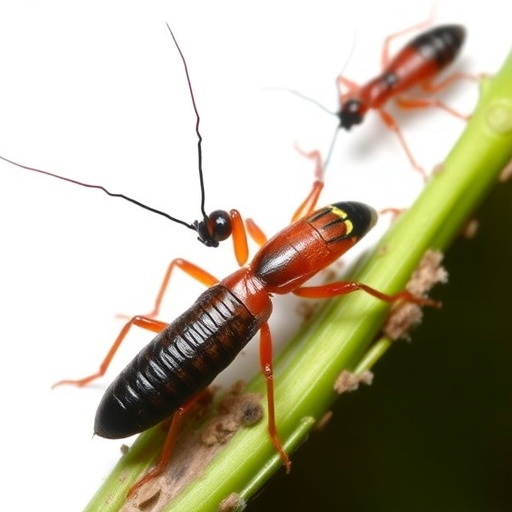
Recent research has unveiled intriguing insights into the reproductive strategies of two cryptic species within the European earwig complex. This groundbreaking study, undertaken by a team of scientists led by Pasquier and collaborators, enhances our understanding of how these insects utilize alternative reproductive tactics to thrive in their respective environments. With an emphasis on both male and female strategies, the findings promise to rewrite aspects of behavioral ecology, shedding light on an oft-overlooked aspect of insect behavior.
Earwigs, classified under the order Dermaptera, exhibit notable diversity, yet some species remain cryptic, making their identification a challenge for entomologists. Because of their elusive nature, understanding their reproductive strategies demands meticulous fieldwork and keen observational skills. Pasquier et al.’s study is pivotal as it pulls back the curtain on the complexities of earwig behavior which had remained relatively obscure until now.
One key aspect of the study involves analyzing the physical and behavioral traits that differentiate these cryptic species. These traits influence mating success and offspring viability. The researchers noted disparities in male genitalia morphology that correlate with specific alternative mating strategies. Such findings bolster the concept that morphological variations in earwigs are not merely a result of random evolutionary processes but are intricately tied to reproductive strategies aimed at maximizing reproductive success.
Interestingly, while males utilize distinct tactics, females are not passive participants in this dynamic. The study also revealed that female earwigs exhibit selective preferences when choosing mates. This selection process is influenced by male displays and behaviors that signal genetic fitness. Understanding this dual-selection process adds another layer of complexity to the ebb and flow of mating dynamics within these earwig populations.
Moreover, the research delves into the energetic costs associated with different reproductive strategies. For male earwigs, adopting a more aggressive mating approach may offer increased access to females, but it comes at the price of heightened risks—such as potential injury during interactions with rival males. In contrast, less aggressive, more subtle tactics may allow for safer, though far less immediate, reproductive success.
The traction between aggressive and non-aggressive strategies is fascinating, especially when considering the evolutionary implications. Adaptations that favor less aggressive behavior can be beneficial, particularly in environments with high population density where competition is fierce. This balance reflects an intricate dance between survival and reproduction that shapes the dynamics of earwig populations on a larger scale.
As researchers further investigate these cryptic species, they are uncovering a treasure trove of information that could reshape our understanding not only of earwigs but also of broader ecological interactions. Lessons gleaned from the behavior of these insects may have parallels in other species exhibiting similar reproductive strategies, providing a blueprint for studying such dynamics across different taxa.
The implications of alternative reproductive strategies extend beyond academic curiosity; they also have practical applications in biodiversity conservation and pest management. Understanding these strategies can inform strategies for managing earwig populations, especially in agricultural contexts where certain species may become pests. By harnessing knowledge of their reproductive behaviors, more effective control methods can be developed, minimizing impact on habitats while maximizing agricultural success.
Equally significant is the role that environmental factors play in shaping these reproductive strategies. Climate change and habitat modification can alter mating behaviors and success rates. Studies like Pasquier et al.’s provide critical insights into how earwig populations can adapt or falter under changing conditions, guiding conservation efforts to maintain ecological balance.
As researchers continue to explore the genetic and environmental underpinnings of these strategies, emerging technologies such as genomic analysis and ecological modeling are set to provide deeper insights. These tools enable scientists to connect receptivity and genetic diversity, predicting how populations might respond to shifts in their environments.
In conclusion, the research led by Pasquier and team on the alternative reproductive strategies of cryptic species within the European earwig complex signifies a significant leap forward in behavioral ecology. It highlights the interplay between physical traits, behavioral adaptations, and environmental contexts in shaping reproductive outcomes among these fascinating insects. The findings enrich our understanding of biodiversity and the evolutionary principles that govern life on Earth.
This investigation not only enriches our understanding of Dermaptera but may also inspire further studies into the evolutionary paths of other organisms. The implications of female choice, male competition, and alternative strategies have dramatic repercussions that resonate through ecological systems, pointing to the intricate and often hidden workings of natural selection.
Understanding the multitude of factors influencing reproductive strategies in organisms like earwigs is a step toward appreciating the complexity of life and the myriad interactions that define ecosystems. As researchers delve deeper into this rich field, ongoing studies will undoubtedly yield further revelations, cementing the importance of continued exploration into the natural world.
Subject of Research: Alternative reproductive strategies in two cryptic species of the European earwig complex.
Article Title: Alternative reproductive strategies in two cryptic species of the European earwig complex.
Article References: Pasquier, L., Dupont, S., Devers, S. et al. Alternative reproductive strategies in two cryptic species of the European earwig complex. Sci Nat 112, 48 (2025). https://doi.org/10.1007/s00114-025-01999-9
Image Credits: AI Generated
DOI: https://doi.org/10.1007/s00114-025-01999-9
Keywords: Alternative reproductive strategies, European earwig, cryptic species, male competition, female choice, behavioral ecology, ecological dynamics, biodiversity conservation, evolutionary biology.
Tags: alternative mating strategies in insectsbehavioral ecology of Dermapteracryptic species of European earwigsDiverse reproductive strategies in earwigsentomological research on earwigsfieldwork in entomologyinsights into insect behaviormale and female earwig tacticsmating success and offspring viabilitymorphological variations in insect reproductionPasquier et al. research findingsreproductive tactics in cryptic insects





